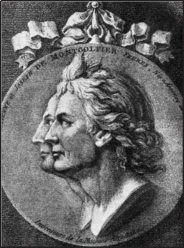- MONTGOLFIER
- FRANCE (see also List of Individuals)\
 26.8.1740 Annonay/F - 26.6.1810 Balaruc/F\The principle of the hydraulic ram may be described as: The potential energy of water can be converted to kinetic energy by a pipeline in which the flow is abruptly stopped; the momentum of the arrested water causes momentarily a pressure rise and forces a portion of the water to a considerable height. By the provision of suitable valves and an air vessel, the cycle can be repeated typically a hundred times a minute, thus providing an almost constant pumped discharge. Today, the water hammer phenomenon is of relevance in hydraulic engineering, of which the bases are similar as those of the hydraulic ram, or the belier hydraulique in French.\Joseph de Montgolfier invented the hydraulic ram in 1797. He was supported by the Abbé Charles Bossut (1730-1814), the famous French experimenter. The design found also its way to England, where James Watt rebuilt the device. de Montgolfier was awarded in 1801 the Gold Medal from the French Society of Encouragement. His interest in pumping machinery based on problems with the pumps of the machine de Marly on Seine River, supplying the Versailles Castle with water from the 17th century. The French Minister of Interior had contacted de Montgolfier; works were conducted in collaboration with his brother Etienne and another friend. Etienne and Joseph de Montgolfier had invented in 1783 the flying balloon and made first voyages that lasted some ten minutes in Annonay. A globe of 10 m diameter and of some 200 kg weight was filled with hot air half as heavy as at normal conditions. The balloon rose to a height of 2,000 m and came down gently at a distance of some 2 km. This attempt exited enormous attention: Joseph left to his brother the honour of reporting to the Académy de Sciences, Paris, and of repeating tests at the government's expense.\Cabanes, C. (1937). Joseph de Montgolfier et le belier hydraulique. Trans. Newcomen Society17: 85-90. PDickinson, H.W. (1937). Early years of the hydraulic ram. Trans. Newcomen Society 17: 73-83. Eytelwein, J.A. (1805). Bemerkungen über die Wirkung und vorteilhafte Anwendung des Stosshebers. Berlin.Montgolfier, J. de (1807). Mémoire sur la possibilité de substituer le bélier hydraulique à l'ancienne machine de Marly. Bulletin Société d'Encouragement pour l'Industrie Nationale 6: 117-124; 6: 136-152.Montgolfier, J. de (1808). Sur la possibilité de substituer le bélier hydraulique à l'ancienne machine de Marly. Journal de l'Ecole Polytechnique 9: 289-317.
26.8.1740 Annonay/F - 26.6.1810 Balaruc/F\The principle of the hydraulic ram may be described as: The potential energy of water can be converted to kinetic energy by a pipeline in which the flow is abruptly stopped; the momentum of the arrested water causes momentarily a pressure rise and forces a portion of the water to a considerable height. By the provision of suitable valves and an air vessel, the cycle can be repeated typically a hundred times a minute, thus providing an almost constant pumped discharge. Today, the water hammer phenomenon is of relevance in hydraulic engineering, of which the bases are similar as those of the hydraulic ram, or the belier hydraulique in French.\Joseph de Montgolfier invented the hydraulic ram in 1797. He was supported by the Abbé Charles Bossut (1730-1814), the famous French experimenter. The design found also its way to England, where James Watt rebuilt the device. de Montgolfier was awarded in 1801 the Gold Medal from the French Society of Encouragement. His interest in pumping machinery based on problems with the pumps of the machine de Marly on Seine River, supplying the Versailles Castle with water from the 17th century. The French Minister of Interior had contacted de Montgolfier; works were conducted in collaboration with his brother Etienne and another friend. Etienne and Joseph de Montgolfier had invented in 1783 the flying balloon and made first voyages that lasted some ten minutes in Annonay. A globe of 10 m diameter and of some 200 kg weight was filled with hot air half as heavy as at normal conditions. The balloon rose to a height of 2,000 m and came down gently at a distance of some 2 km. This attempt exited enormous attention: Joseph left to his brother the honour of reporting to the Académy de Sciences, Paris, and of repeating tests at the government's expense.\Cabanes, C. (1937). Joseph de Montgolfier et le belier hydraulique. Trans. Newcomen Society17: 85-90. PDickinson, H.W. (1937). Early years of the hydraulic ram. Trans. Newcomen Society 17: 73-83. Eytelwein, J.A. (1805). Bemerkungen über die Wirkung und vorteilhafte Anwendung des Stosshebers. Berlin.Montgolfier, J. de (1807). Mémoire sur la possibilité de substituer le bélier hydraulique à l'ancienne machine de Marly. Bulletin Société d'Encouragement pour l'Industrie Nationale 6: 117-124; 6: 136-152.Montgolfier, J. de (1808). Sur la possibilité de substituer le bélier hydraulique à l'ancienne machine de Marly. Journal de l'Ecole Polytechnique 9: 289-317.
Hydraulicians in Europe 1800-2000 . 2013.
